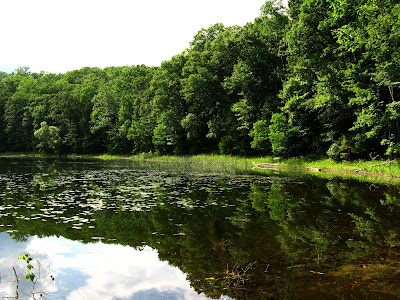
Pine needles swirl on a Woods Hollow pond, as the storm clouds swirled in the sky above.
When will we have a day without storms? Now, I don't mind a little rain, but every day, for ages it seems, the forecast has been for severe thunderstorms, with high winds and lightning and even the chance of hail. Not the kind of weather you want to overtake you while out in your solo canoe. Luckily, I know some wildflower sites to explore on foot, and not too far from a parking lot should the worst weather come upon me with little warning.
My first stop today was Woods Hollow Nature Preserve in Ballston Spa, where I thought pretty Dewdrop (Dalibarda repens) might be in bloom. And so it was: pristine white flowers against dark-green heart-shaped leaves, carpeting the ground in damp shady places. Its blooming period has just begun. We should see this flower all summer long, even into September.
The next flower I found in bloom today is one I can hardly believe I ever discovered (especially with my bad eyes). Water Pennywort (Hydrocotyle americana) also loves damp shady spots, and I'd seen its pretty, pale-green, broadly heart-shaped leaves with scalloped edges for years, wondering if it might ever come into bloom. Then one day I parted its densely clustered leaves to discover, voila! it was already in bloom! It's just that its flowers are not only tiny, and not only hidden down under the leaves, but also nearly invisible, being translucent as well as exactly the color of its stems.
I was delighted to find Pipsissewa (Chimaphila umbellata) blooming at Woods Hollow, especially since I saw it only in bud at Moreau yesterday. I guess 25 miles farther south might make a difference in blooming time. The shiny evergreen leaves of this plant are pretty all by themselves, but the nodding waxy white flowers with pinkish centers are something to behold.
Especially if you turn them over to see their undersides. Such odd little tubular structures surrounding the central style! I wonder, are those the real petals, and the waxy white parts are the sepals? Nope. My Peterson's guide refers to "its ring of reddish anthers." The pistillate part always looks wet and shiny. Is it sweet? The flies sure love it!
And here's someone who really loves flies. To eat, that is. Big fat Bullfrog sitting on a log. Or is he a giant-sized Green Frog? (He was bigger than a man's fist.) So nice of him to sit there so I could take his picture. Most of the frogs around the pond at Woods Hollow leap with a squeak when they sense me coming. Eeep! Eeep! Eeep! If they'd just lie low and shut up, I'd never see them. I'm glad I saw this guy.
Next stop was the public fishing pier at Ballston Lake, where the surrounding swamp is filled with Swamp Rose bushes. Their exquisite fragrance helped me overlook the trash the public left all around that site. Here were Water Lilies and Pickerel Weed and pretty yellow Fringed Loosestrife growing wild. They, too, helped me keep my eyes on the prize: the abundance of interesting plants that grow at this site. Branching Bur Reed and Water Plantain were blooming alongside the road in watery ditches, but what caught my eye today were these nasty invasive Canada Thistles (Cirsium arvense). So far, they seemed to be confined to a gravelly railroad right-of-way. Given half a chance, they'll drive every other plant from the land. At least the bees seem to like them. These were really big bees.
Another alien "weed" I always find at this site is Centaury (Centaurium umbellatum). I've never found this plant anywhere else, and it's some kind of miracle I ever saw it here. A native of Europe, it grows in the hard-packed gravel right next to the road, where the mowers cut it down to less than an inch, and its flowers are minute -- maybe 1/4 inch across, if that. It must be its color that caught my eye: a vivid raspberry red, with a yellow center.
.JPG)
I got some very strange looks today, lying down in the dirt to close-focus on these tiny plants, cars and trucks whizzing by so close they ruffled my hair. And then the wind blasted my hat from my head, as a raging storm raced upon me, raindrops spattering the gravel where I lay. Those little Centaury flowers quickly closed their petals up tight, and I figured I'd better seek some shelter, too. More storms are predicted for tomorrow and also for Thursday. When will I ever get out on the river again?















































